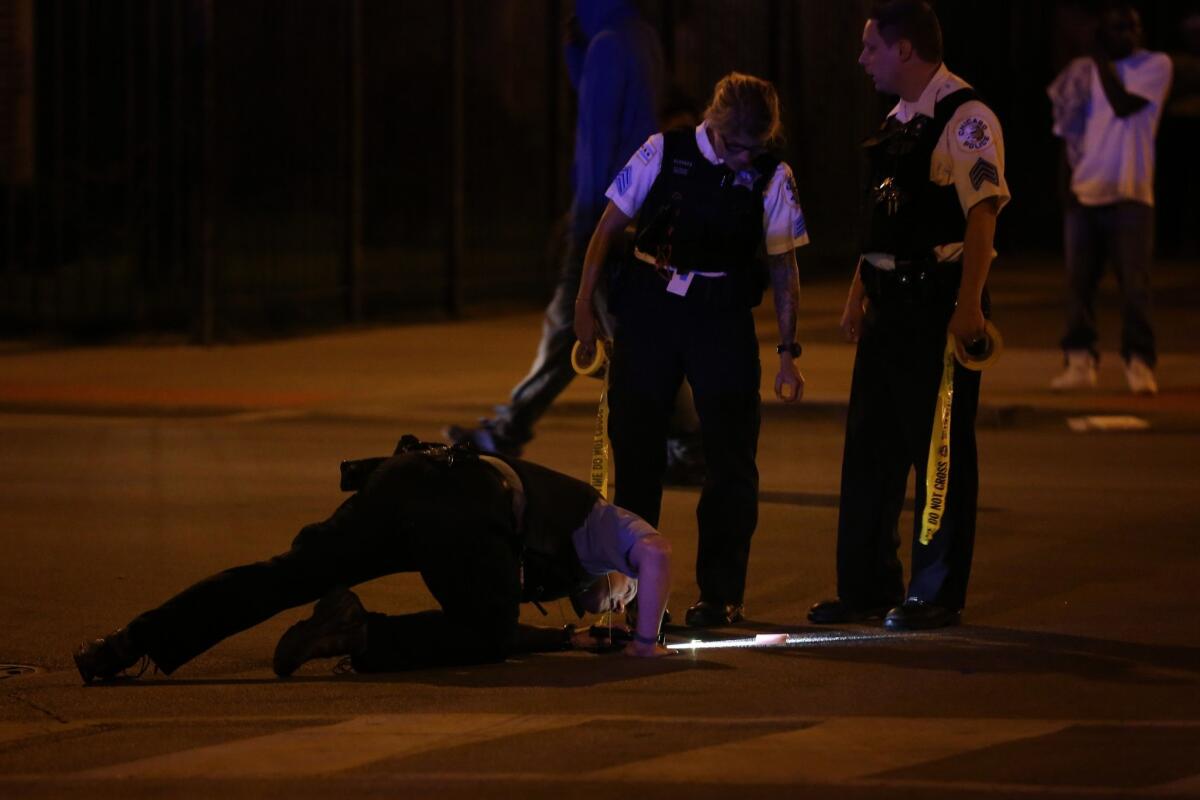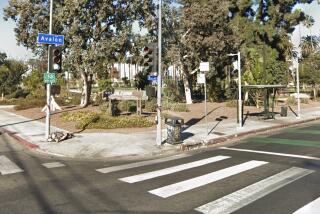11 shot, including 3-year-old boy, as Chicago gun violence worsens

- Share via
Chicago is grappling with a crime paradox this summer: Even as overall crime including homicide drops, the rate of shooting incidents isn’t slowing down and threatens to surpass previous years.
The city’s violent summer continued Friday with at least 11 shootings, including one that left a 3-year-old boy hospitalized in critical condition.
The boy and a friend found the gun while at a home in a neighborhood on the city’s West Side, and the boy was shot when it went off, police officials said. The child remains hospitalized in critical condition.
Officers are seeking the boy’s father, who owned the gun and is out on parole.
Friday’s shootings were the latest gun-related incidents in a recurring struggle for many Chicago communities. The city saw 205 incidents in 28 days, according to the most recent police statistics, with a higher number of shootings this year than the same time last year.
The boy’s shooting comes only days after a 9-year-old boy was shot and killed on the city’s South Side. Detectives are still investigating that case and have no suspects in custody.
Friday’s shooting highlighted what Chicago’s political leaders say is one of the main reasons behind the city’s stubbornly high gun violence rates: easy access to firearms. A report earlier this summer from Chicago Mayor Rahm Emanuel’s office put it bluntly: “Chicago’s violence problem is directly linked to the number of illegal guns available in the City.”
Emanuel pushed for stricter oversight of the city’s gun shops in May, in hope of cutting down on “straw” purchasers who buy guns on behalf of someone else. The mayor’s proposal came after a federal ruling in January that overturned the city’s ban on gun sales.
And in June, a new federally run data center in the city was tasked with studying the firearms used in Chicago shootings to detect trends in purchases and use.
Police have used other methods to combat the shooting epidemic, including analyzing social connections among residents of violent neighborhoods to determine who is most at risk of becoming a shooter or a victim. Many of these efforts are based on academic research, including a 2013 study from Yale University that found 6% of residents in a violence-plagued section of Chicago accounted for 70% of the homicides in that area.
But most policymakers acknowledge that the solution to Chicago’s violence problem can’t come solely from law enforcement. Researchers at the University of Chicago and other institutions have shown that while large portions of the city have become safer in the last decade, violence and crime have become entrenched in others.
To find alternative solutions, the National Institutes of Health funded a DePaul University program in May to work with Chicago ninth-graders on managing stress amid violence.
Program directors say coping mechanisms are essential for students exposed to shootings and gang activity because chronic violence can quickly become the norm for young people raised in an unstable environment.
“The students we are working with are negotiating a number of factors,” said LaVome Robinson, a psychology professor at DePaul who leads the study. “They are negotiating schools that might not be particularly safe, they are negotiating getting to school on streets that are not particularly safe, and they are negotiating going home to homes that are not particularly safe.”
The stress management strategies taught within the program, which will run for five years in Chicago public schools, could help reduce stress levels in children who might otherwise struggle with violence and aggression, she said. After all, she notes, the children she works with are no different from any other adolescents, only trapped in extreme circumstances.
“They are children with enormous stress that a lot of children don’t have to encounter,” Robinson said.
While rates of most types of crime are on the decline, the number of shootings in Chicago is 5% higher at this point in the year compared with the same time last year, according to police data.
A recent spate of summer violence, in particular, has captured the interest of policymakers and the media. Confrontations over the July 4 holiday weekend earlier this summer resulted in 82 people shot, with 16 killed, and led Emanuel to urge residents to protest the attacks.
“This violence is unacceptable wherever it occurs in our city and all of us need to take a stand,” Emanuel said in a statement.
More than 1,200 people have been shot in the city since the beginning of the year, according to the latest available data collected by the Chicago Tribune. More than 2,000 people were shot over the course of last year.
Chicago came under fire in 2012 when its homicide rate topped 500, higher than rates in New York and Los Angeles. Since then, homicides fell in the city by 18% in 2013, and are on track to fall again this year, according to law enforcement data.
Contact Matt at matt.hansen2@latimes.com or @mtthnsn.
More to Read
Sign up for Essential California
The most important California stories and recommendations in your inbox every morning.
You may occasionally receive promotional content from the Los Angeles Times.













